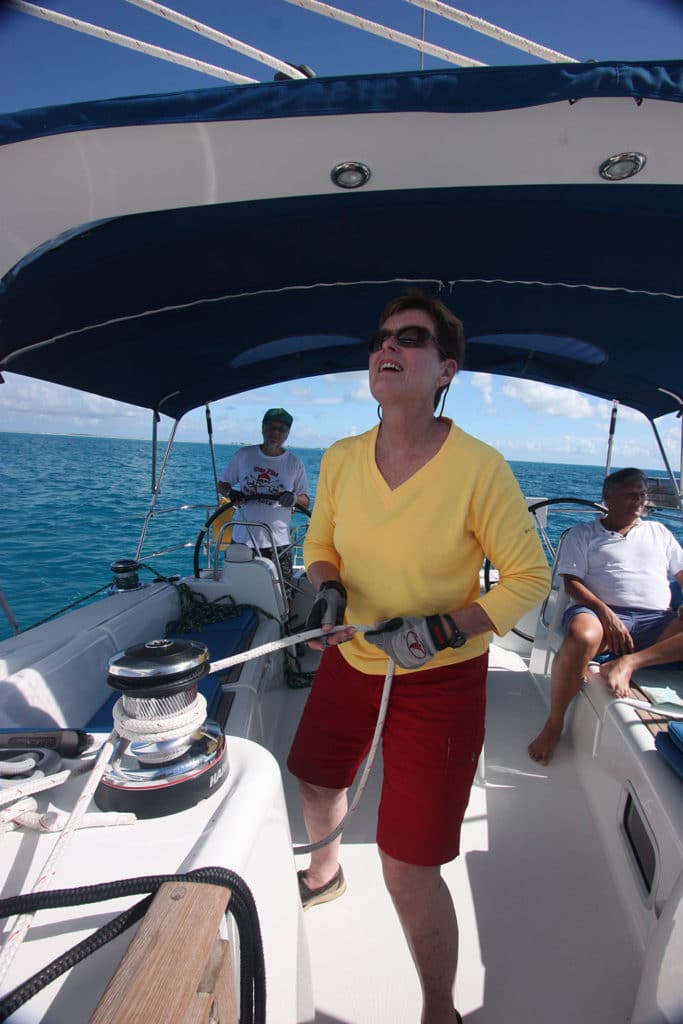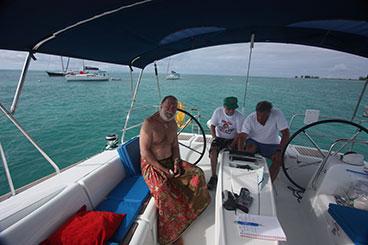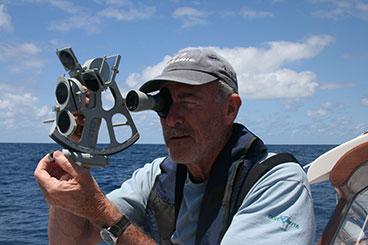
Professor Salt
When Steve Colgate of the Offshore Sailing School called and left a message saying that he wanted me to teach sailing in the British Virgin Islands aboard a fleet of Moorings 50.5s, built by Beneteau, I was shocked. What—was he insane?
“Steve,” I said, when I finally got him on his mobile phone,
“I’m really not much of a sailor. I’m more a get-blown-downwind guy.”
“No problem,” he replied. “We’ll have two instructors, Mike and Kevin, to explain the technical stuff. Can you help us set the cruising tone by telling a few sea yarns?”
The recipe was simple: Take students who wanted to practice their big-boat sailing skills and ship them down to paradise. Add one salt-stained jokester, two knowledgeable sailing instructors, many evening bottles of Pusser’s rum, and stir vigorously.
The result was an amazingly fun week in the BVI during which the eager participants laughed and learned until the wee hours of each evening. They were a highly diverse group, with the only common denominator being a thirst for both learning and hands-on experience.
One day, I sailed on a boat with three kidney doctors. It made me check my lower back, after a nap, for stitches. And yes, the cockpit shoptalk made me ill!
Besides their official roles as teachers, Mike Huffer was our social director and moral compass. Kevin Wenley was a bit more focused; he brought his white-board and tactical game plan aboard each day and put all the crews through various drills and maneuvers.
I gave morning talks on such topics as offshore safety, reefing early and well, and storm tactics. My evening addresses were looser; that’s when I went for the laughs. And yes, of course, I brought my guitar.
My favorite guest was Fred the Fisherman. I figured he’d be an unusual fellow, because who else would sign up for a learn-to-sail course so they could troll the North Drop, off St. Thomas, for blue marlin at 5 knots? Yes, he thought way outside of the tackle box. His fishing rig consisted of an ancient reel carrying what I’d estimate was three-ounce test line, a large lead sinker, a tiny hook, and a dozen whole frozen conch. Some of us speculated that he kept the bait under his pillow; all we know is that by the end of the charter, the fine folks at The Moorings gingerly approached his cabin dressed in hazmat suits! Fred’s fishing routine was odd, too.
Often he’d wait until we were anchored in a safe harbor, then eagerly drag his fishing gear into the cockpit. He’d toss his heavy sinker and frozen conch over the side on the monofilament line thinner than a human hair, then prop his Penn reel and rod up against the stern rail. Everything would be fine for about three or four minutes, and then the Moorings 50.5 would swing on its anchor rode, which would tug the fishing line and knock over the pole. No matter where Fred was on the vessel, he’d stampede aft, grab the still-bouncing reel, scream, “I got one! I got one!,” and then give a giant tug to set the hook. The tug would, of course, snap the line and cause him to scream in outrage, “The bastard stole my bait again!”
He did this a dozen times or so, and none of us could convince him of reality. He was determined, he said, to “fight one to the death, just as Hemingway would!”
This would’ve continued all week, but I finally got him to use 50-pound test in order to, as I put it, “make it more sporting for you!”
That evening, anchored off Jost Van Dyke, he managed to hook the reef itself and thus snap his fishing pole in half while setting the hook. It was the end of Fred’s fabulous fishing career. Everyone sighed in relief, and a few chimed in: “I saw it skywalking, Freddy!” and “That blue marlin was huge—a world record, for sure!”
For the rest of the trip, he’d strut around and say, “It was like hooking a freight train!”
Now I’d been thinking that Freddy wasn’t the sharpest filleting knife in the tackle box, but one day he nonchalantly said to fellow student Linda Ross, “No, there’s only one tack line on the jib, but yeah, there’s two sheets. The one not being used is called the lazy sheet. And, yeah, the jib car might come aft a couple of inches, right, Fatty?” Maybe he was learning how to sail!
I know I was learning a lot about human nature. Many of those who said they knew the least actually knew the most. And the ones who asked questions learned the answers, unlike their more timid counterparts who never voiced their queries.
Take the lovely lady named Christine Meade, for example. She’d just come from the hairdresser, and she announced that she didn’t mind sailing if it wouldn’t mess up her ’do. Learning this, I made sure, of course, that her hair got immediately splashed by saltwater and had sun block dripped on it and a tube of lip-balm melted into it, all within the first hour of hoisting the mainsail. Once her hair looked more like the fur on a sewer rat, we let fly with our best stuff: “Who does your hair, Chris? Do you fly them in?” and “How do you manage to maintain that sexy windblown look?” and “I mean, you own the salty-sailor-gal image, Chris, like, totally!”
Chris, however, wasn’t easily distracted. Her goal was to master the crew-overboard drill. She wanted to pick up her husband, Bob, if he ever went over the side of the steel sloop he’d been building for the last decade or two.
“You wanna learn how to go back and pick up Bob?” we chorused. “I mean, if you picked up Fred, at least you’d have fish stories for the rest of your life. But with Bob?”
Bob was one of the kidney doctors, and he was obsessed with the Polynesian wrap, called a pareo, that I wore.

| |Casual attire: Fatty does a pair of T-shirt-clad students one better; wearing his pareo to class.|
“Where can I special order one?” he asked, pencil poised to order up one of his own.
“It’s just a piece of fabric,” I said.
“What’s the mechanism that secures it?” he pressed on.
“It is just a piece of fabric,” I said.
“How do you know which is the front?”
“It’s just a piece of freakin’ fabric!” I shouted.
One time, I unexpectedly came down belowdecks and discovered him in my cabin, fondling the fabric. “It’s so soft!” he said, as if that explained it all.
Needless to say, I had the pareo gift-wrapped at Saba Rock and secretly tucked it into his luggage.
The point I’m trying to make with all the silliness above is that I’d worried that the students might be a tad too serious for my laid-back cruising tastes. Not so. They were wonderfully relaxed, which is, perhaps, nurtured by the real instructors. Random events seemed to seamlessly deliver the message that “Hey, sailing is fun. It isn’t hard. Sure, we can learn to sail better and better and sail more efficiently, but the main thing about sailing is to enjoy each other and enjoy King Neptune’s world and savor the pure sensuous pleasure of being propelled by the wind in complete, cosmic harmony with the universe.”
Does that sound too highfalutin? If you’re a sailor, it doesn’t.
You can go to a Zen master or you can go sailing, but in this reporter’s humble opinion, you end up either way in about the same place.
The other thing that amazed me was how nurturing everyone was. Everyone was there to learn and be hands-on, so no one hogged the helm or excluded anyone from any activities.
Instead, we urged each other to expand comfort zones. When Howard Leibowitz, another doctor, admitted that he was slightly nervous to sail in close quarters, we assigned him to the wheel while we were picking up the mooring.
There was a boat directly ahead, and another close on our starboard quarter. The wind was at 18 to 22 knots and gusting. There was a slight cross current. At first, Howard made the classic mistakes of using too much throttle and too much speed, but as soon as he got the slow-is-pro idea, there was no problem.
He slipped into the small slot and stopped the boat nicely at the mooring float as the pendant was secured. I renamed him Big Balls Howard, a boat-handling designation he will take home and wear proudly at his local yacht club.
At first, I was worried about the varying skill levels. For instance, Cap’n Bruce Penrod had lots of experience and appeared born to take the helm, while some of the crew were sailing on a big boat for the very first time. But this disparity of skills actually was a plus. Often, the best instructors turned out to be the students themselves, and we instructors were only there to facilitate their personal journey.

| |Bluewater experience doesn’t come easy. The best way to learn what it’s like offshore is to go offshore.|
And people surprise you. Fred the Fisherman wasn’t too graceful with a reel in his hands, but he really knew how to cut a rug on the dance floor.
I danced with Linda Ross until I could sense the frowning local West Indians were about to dial up my wife, Carolyn, on their mobile phones.
Each of us came away with some precious memories. My favorite moment starred Olga Maryasis, who, along with her husband, Isaac, had escaped from behind the Iron Curtain for America many decades ago.
I assigned her to pick up and secure the mooring pendant. I could see her hesitancy. Dark clouds flicked across her countenance. I did my best to reassure her. “Don’t worry,” I said. “It’ll be easy. The secret to doing something fast is often to do it slow. Don’t panic. Just do it as I showed you.”
She set herself up well, and she’d clearly thought out how to perform her task. She picked up the line and was going to secure it correctly when a helper grabbed it and passed it through the bow rail incorrectly. If left that way, it would foul badly as the strain took up; perhaps it could even have ripped off the bow rail.
I debated whether to intercede, then chose not to.
Olga froze for a second. She knew something was wrong. I could see the wheels turning. Then she rerove the mooring line and tossed its standing end over the side just as it became taut. When it was apparent that she’d done it correctly, a look of joy sprang onto her face. She’d just done something she’d never thought she’d be able to do, and she’d done it well. She leaped into the air like a happy schoolgirl and screamed, “Yes!”
Toward the end of the week, we raced from Virgin Gorda to Anegada. It was a picture-perfect trade-wind day, and there was plenty of time to tweak our sails, explain the mysteries of the cunningham, and play with our jib-car placement. Despite the fact that I spent most of the time rooting through our cooler in search of Perrier—or, perhaps, because of that—the vessel I was aboard came in first by a decent margin.
Thus, I was presented with a natural teaching opportunity regarding sportsmanship and maturity.
“OK,” I said to the winning crew. “Here are the important questions to ask your fellow competitors at the lobster feast tonight: ‘Are you sure you had your anchor up?’ ‘Could your engine have been stuck in reverse?’ And ‘Gee, you guys were out there so long. Did you have to factor in continental drift?'”
Sorry, yacht racing always brings out the worst in me.
Over the course of the week, the sea worked its magic. It always does. We all ended up as sailing buddies. I gave each participant a custom-made book and invited one and all out to our 43-foot ketch, Ganesh, for tea. Carolyn was, understandably, a bit shocked when I showed up after a week’s absence with a dozen sailors in tow.
“You brought your students back?” she asked.
“No,” I told her. “I brought my friends.”
For offshore sailing opportunities click here
Cap’n Fatty and Carolyn Goodlander have replenished their cruising kitty and are getting ready to set off to spend their easy-earned freedom chips in French Polynesia.







